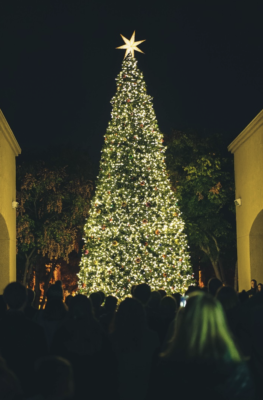
For many Americans and Canadians, Thanksgiving marks the beginning of the holiday season, culminating with celebrations at Christmas, New Years Day, and for some, on the “Twelfth Night” on January 5th. From Christmas trees to mistletoe, to pine cones, holly and ivy, the tradition of “bringing the outdoors indoors” during the holidays is commonplace and widely cherished. But where does this tradition come from, and why do evergreen trees of spruce, pine, and fir remain at the center of this custom? We wanted to know more about why Christmas trees appear so ubiquitously throughout town squares across North American, in farmers markets, grocery stores, and ultimately inside our own homes. Accordingly, we consulted Associate Professor Justin Nolan in the Department of Anthropology at the University of Arkansas, where Nolan’s two decades of research in expressive culture in North America have informed his understanding of the relevance of folk traditions and public folklore more broadly. Nolan himself is examining present-day social customs and holiday traditions and how plant and animal symbols feature prominently within then. He seeks to understand where they stem from, and how they replicate, maintain and revitalize cultural beliefs, practices, and everyday meanings in contemporary society.
Early Use of the Evergreen
The history of the Christmas tree goes all the way back to the symbolic ‘appropriation’ of evergreens in ancient Egypt and Rome. Long before the advent of Christianity, Justin Nolan explains that evergreens and other cone-bearing and berry-producing greenery—all of which remain green all year round—had special significance for peoples in throughout Eurasia and beyond during the winter solstice. The ancient Egyptians are known to have worshipped a god called Ra, who wore a sun as a blazing disc on his crown and represented the warmth and life of the sun. During the solstice, the Egyptians filled their homes with green palm rushes, which for them, symbolized the triumph of life over death. Additionally, early Romans marked the solstice with a feast called Saturnalia in honor of Saturn, the god of agriculture. To mark the occasion, they would decorate their homes and temples with evergreen boughs and garlands.
Bringing evergreens indoors was a practice widely associated with Paganism, in which evergreen trees and plants represented life, regeneration, and the robustness required to endure the harshness of the winter months. For Pagan peoples, the time between December 25th and early-mid January were and remain the coldest days of the year, and it was believed that spirits of darkness were at their strongest during these months. In the Northern Hemisphere, the shortest day and longest night of the year falls on December 21stor 22nd—the winter solstice. Pagans also celebrated this time as the nexus of life, rebirth, and renewal as did Romans and Egyptians and other ancient societies. Justin Nolan explains that several cultures believed the sun embodied god or a powerful deity, who became weak and devitalized during the winter months. Ancient peoples commemorated and celebrated the solstice because it served as a promise of perpetuation. The solstice marked a passageway through the time of year when the sun would begin, at last, to strengthen and brighten to revivify the world with light and warmth.
For Pagans and other ethnic groups across Northern Europe, bringing evergreens into the home was an act of guardianship, faith, and protection. Over time, evergreens were decorated joyfully with brightly colored paper flowers and fruits; they would later be lit up with candles which represented the promise of life, light, and restoration, even through the passing of the coldest, darkest nights of the year. In addition to procuring evergreens, Pagans often used branches of fir trees and braided garlands of holly and ivy over doorways and thresholds to provide goodwill, protection, and fertility to those who pass below them.
The Christmas Tree and Christianity

There are several theories, legends and speculations explaining how evergreen trees became a focal symbol for the Christian celebration of Christmastime. One of the these is credited to the English monk Boniface, who was famous for his missionary work in Germany during the 8th century. According to the story, Boniface encountered a group of native Germans performing sacrifices before a massive oak tree (which is sacred to the Norse god Thor). Boniface bravely seized their axe in effort to thwart their ritual worship of a false idol. When Boniface chopped the tree to the ground, the Germans were certain the monk would be struck down by lightening as vengeance. However, the native Germans stood in awe as he remained unharmed and were consequently converted by Boniface’s teachings. Legend has it that a fir tree grew from the stump of the oak chopped, and its triangular shape came to be associated, visually and spiritually, with the Holy Trinity—the father, son and holy spirit.
An additional line of inquiry reveals that Christmas trees began to emerge in homes and villages across Western Germany during the 16th century. At this time, Christians started bringing trees into their homes, while some built pyramids of wood and decorated them with branches of evergreens and candles. According to Nolan, the geographic origins of the Christmas tree most likely span from Northern Germany to the Baltic region of Europe, including Estonia, Latvia, and Lithuania. Traditional decorations in this region included ribbons, fruits, paper ornaments and garlands, and later, confectionaries and candles. It is a widely held belief that Martin Luther, the 16th century protestant reformer, was the first to add lighted candles to a tree. It is said that as he was walking home from a winter sermon, he was so moved by the magic and beauty of the nighttime stars twinkling in the frozen sky, he opted to recapture the scene for his family by adding candlelight to his tree.
Interestingly, most 19th century North Americans considered the practice of tree-decorating to be esoteric. The custom maintained a residual association with Paganism, and thus it was not widely quickly adopted by the mainstream during this period. The first recorded Christmas tree on public display occurred in the 1830s, when German settlers in Pennsylvania commemorates the season with the practice. In 1846, Queen Victoria and her German prince, Albert, were sketched in the Illustrated London News, standing with their children around a Christmas tree. Nolan explains that the 19th-century German holiday carol “Oh Tannenbaum” memorialized the custom through song.
Today, Christmas trees serve as a focal point for festivity and gatherings, the giving and receiving of gifts, the “coming together” of family members and “opening up” with friends. Even today, evergreen trees and brightly colored garlands, lights and ornaments convey the power of durability, the strength of the giving spirit, the promise of regeneration, and the sacredness of rebirth and renewal. For many Americans and Canadians, Christmas trees are generally erected inside and decorated customarily after Thanksgiving. Christmas trees are removed on the “twelfth night”, or the Epiphany, on January 6th. However, they are understood, Christmas trees remain emblematic of the staying power of human beliefs, values, hopes, promises, and sentiments, including their manner of cultural construction and expression.


